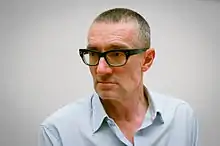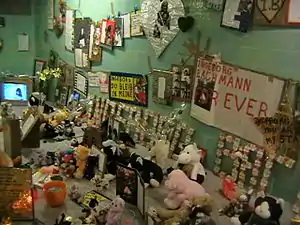Thomas Hirschhorn
Thomas Hirschhorn (born 16 May 1957 in Bern) is a Swiss artist. He lives and works in Paris.[1]
Thomas Hirschorn | |
|---|---|
 Hirschorn in June 2014 | |
| Born | 16 May 1957 |
| Nationality | Swiss |
| Education | Kunstgewerbeschule Zürich |
| Known for | Sculpture, Art in Public Space |
| Movement | Contemporary art |
| Awards | Marcel Duchamp Prize, Joseph Beuys Prize, Kurt Schwitters Prize, Prix Meret Oppenheim |

Life and works
In the 1980s, Thomas Hirschhorn came to Paris with the will to take part in the 'Grapus'-collective as graphic designer, because he was impressed by the way their graphic work was also politically engaged. Although he and the Grapus people were good friends, working with them wasn't what he wanted to do. He didn't want to work for clients, but wanted to create for his own. During the long years that followed, he developed his own visual research based on the principle of Collage. In the beginning, he claimed these as 'Graphic design from myself,' but was not more successful until he decided to clearly position his Collage-work in the field of art and history of art.
He then started to create the hypersaturated works he is known for today, using common materials such as cardboard, foil, duct tape, and plastic wrap. He has described his choice to use everyday materials in his work as "political" and that he only uses materials that are “universal, economic, inclusive, and don’t bear any plus-value”.
He has said that he is interested in the “hard core of reality”, without illusions, and has displayed a strong commitment to his work and role as an artist.[2] He has described working and production as “necessary”, discounting anyone who encourages him to not work hard, and says “I want to be overgiving in my work”.[2]
For his piece Cavemanman, he transformed a gallery space into a cave using wood, cardboard, and tape and put various philosophical and pop culture symbols throughout it.[3]
Gramsci Monument (2013), named after the Italian thinker Antonio Gramsci, is the first project that Hirschhorn has built in the United States and the fourth and final such work in a series he began many years ago dedicated to his favorite philosophers, following a monument dedicated to Baruch Spinoza in Amsterdam in 1999, one to Gilles Deleuze in Avignon, France, in 2000 and a third to Georges Bataille in Kassel, Germany, in 2002. From the beginning, the monuments have been planned and constructed in housing projects occupied mostly by the poor and working class, with their agreement and help.[1]
He presented a lecture as part of the "Image & Text: Writing Off The Page" lecture series through the Visiting Artists Program at the School of the Art Institute of Chicago in Spring, 2006.
Exhibitions
Hirschhorn's work has been the subject of numerous solo exhibitions including the Institute of Contemporary Art, Boston; Centre Georges Pompidou, Paris; Museu d'Art Contemporani, Barcelona; Kunsthaus Zürich; Art Institute of Chicago; Museum Ludwig, Cologne; and Wiener Secession, Vienna. In the summer of 2009, his work Cavemanman was recreated for the exhibition Walking in my Mind at London's Hayward Gallery.[4]
Collections
Hirschhorn's works are held in collections worldwide, which include the Museum of Modern Art,[5] the Walker Art Center,[6] and the Tate among others.[7]
Recognition
Hirschhorn received the (2000/2001) Marcel Duchamp Prize, the Joseph Beuys Prize in 2004 and the Meret Oppenheim Prize in 2018. In June 2011, Hirschhorn represented Switzerland at the Venice Biennale.
Thomas Hirschhorn is represented by Gladstone Gallery, New York; Chantal Crousel, Paris; Stephen Friedman Gallery, London; Alfonso Artiaco, Naples and Dvir Gallery, Tel-Aviv.
References
- Randy Kennedy (June 27, 2013), Bringing Art and Change to Bronx New York Times.
- Cruzvillegas, Abraham http://bombsite.com/issues/113/articles/3621 “Thomas Hirschorn” in BOMB Magazine, Fall 2010. Retrieved July 26, 2011
- Kimmelman, Michael (2002-11-15). "ART IN REVIEW; Thomas Hirschhorn -- 'Cavemanman'". New York Times. Retrieved 2008-08-19.
- Hayward Gallery "Walking in my mind, Adventure into the artist's imagination"
- The Museum Of Modern Art - The Collection, moma.org
- Walker Art Center - Collections Archived 2011-09-30 at the Wayback Machine, collections.walkerart.org
- Tate - Art & artists, tate.org.uk
External links
- Artist's web-site
- Thomas Hirschhorn at Stephen Friedman Gallery
- 2008 Life on Mars, the 2008 Carnegie International
- 2007-08 "Thomas Hirshhorn at Musée d'art contemporain de Montréal"
- Haidu, Rachel, "The imaginary space of the wishful other: Thomas Hirschhorn’s Cardboard Utopias." Vector e-zine, January 2006.
- 2006 "Someone Cares," in Fillip
- 2001 "Thomas Hirshhorn at Stalingrad Station", Paris, Sculpture magazine
- Artist's short biography,
- "Thomas Hirschhorn". SIKART Lexicon on art in Switzerland.
- TateShots at the Venice Biennale 2011: Thomas Hirschhorn at the Swiss Pavilion The artist talks about his contribution to the Venice Biennale, 2011-06-08
- Thomas Hirschhorn by Museo Cantonale d’Arte Lugano